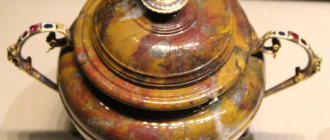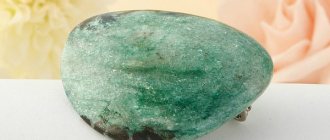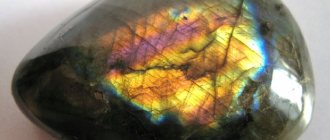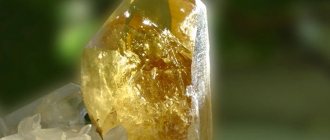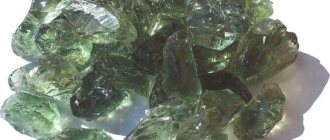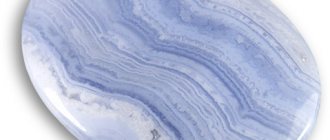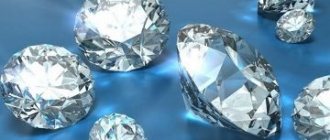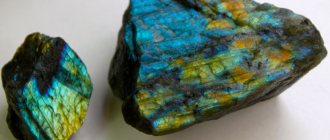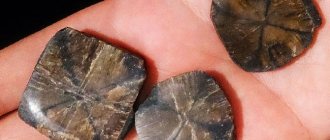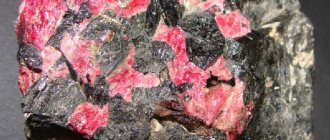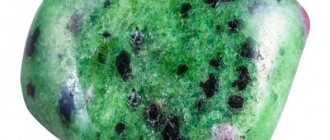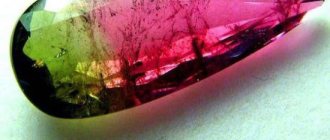History and origin
It is believed that the first gems were discovered in Southeast Asia. People were delighted with the strength of the mineral and associated many legends with it. They called it corundum.
Sapphire
Versions about the origin of the name “sapphire”:
- from the ancient Greek σάπφειρος - “blue stone”;
- from the Babylonian “sipru” - “scratching”;
- from Sanskrit – “favorite piece of heaven.”
In Ancient Rus' it was called azure yakhont, and all blue minerals were then called “bausy”. According to Indian legend, blue corundum is amrita, the elixir of immortality. The creator petrified the liquid so that people would not use it. The importance of blue sapphire as a symbol of power is indisputable. A rich natural (without refining) gem is an attribute of the first pontiffs and rulers, for which it is called royal.
King Solomon owned the sapphire seal. Style icon Lady Di loved jewelry with gems. Her daughter-in-law Kate Middleton received an engagement ring with a pink stone that Diana once received from Prince Charles.
Today, for a jeweler, sapphires are all corundums, except red (which is a ruby). For a mineralogist, sapphire is only blue corundum.
Jupiter stone, symbol of prosperity
The gem in India has always been considered a symbol of wealth and prosperity. Everyone who strives for well-being tries to wear stone jewelry. The Hindus were sure that the stone supplied its owner with prana - life force.
In Ancient Rome and Ancient Greece, sapphire was the stone of Jupiter (Zeus).
There is a legend about the sapphire ring of Alexander the Great.
What such a ring was worn by Mary Stuart (the story of her tragic life was described by S. Zweig, anatomizing in detail the life and feelings of the unfortunate queen) is known for certain. The ring is now in the Hamilton family castle, Lennoxlove House, near Edinburgh in Scotland.
Help mineralogists
It is not known exactly where the name of the stone came from.
Mineralogists have several versions:
The Greek word σάπφειρος means blue stone .
In the Roman Empire the gem was called cyánus ( cornflower ).
In Hebrew and Persian the name sounded like sapir .
In Russia, the stone was called azure yakhont .
Physicochemical characteristics
Sapphire is a variety of corundum and is the top tier of the four most expensive gemstones. It is surpassed in hardness only by diamond.
Heat treatment discolors the crystals; exposure to x-rays increases the density of the sapphire color.
| Formula | Al2O3 |
| Color | Blue and cyan in various shades; colorless, pink, orange, yellow, green, purple, black |
| Shine | Glass |
| Transparency | Transparent to opaque |
| Hardness | 9 |
| Cleavage | Absent |
| Kink | Rough to conchoidal |
| Density | 3.95 - 4.00 g/cm³ |
Physical properties of sapphire stone
Corundum is one of the hardest minerals; its characteristics are second only to diamond. In terms of price, it is among the top five most expensive. The saturation of the shade is determined by the percentage of titanium and iron.
If sapphire is exposed to high temperatures, the color disappears.
However, under the influence of X-rays, the saturation level increases by an order of magnitude. Gems after this treatment are called refined.
Place of extraction
Several countries conduct industrial mining of the mineral. Top class cornflower blue specimens are mined by hand in Kashmir at an altitude of 4000 m for four months of the year when the mountains are free of snow. Australia produces 80 percent of all stones, but they are inexpensive, in price terms only a quarter of the world market.
Sapphire
Padparadscha, rare pink and blue “Ceylon” gems, come from the island of the same name. Thailand, Myanmar (Burma), Vietnam and Cambodia are rich in greenish “Siamese” minerals. Multi-colored specimens are found in Africa (Tanzania, Kenya) and the USA. In Russia, non-jewelry raw materials are mined in the Urals and Khibiny Mountains.
Where are sapphires mined?
Industrial centers for the extraction of gems are located in the United States of America, the People's Republic of China, Thailand, Madagascar and some other areas.
A fun fact is that the largest sapphire currently available was found by chance and was mistaken for crystal.
For a long period of time it was used as a paperweight, but after contacting an expert, it turned out that it was really a gem. The discovery took place in the sixties of the twentieth century, in the United States of America.
There is no mass mining of sapphire in Russia. Sometimes found on the Kola Peninsula, the local stone is gray in color.
Varieties and colors
Sapphires have a wide range. A blue crystal is considered a classic. The remaining shades are “fantasy”.
Colors
There are yellow, orange, green, colorless, pink, black specimens. In this case, the description of the stone includes an indication of color.
- Blue. A classic but rare sapphire color. More often it is a mineral with bluish, grayish tints. A specimen containing up to 15% of other shades is considered blue. If it is more, the stone is classified as fancy with a double name (for example, yellowish blue). Color is created by titanium and iron: the more, the thicker the shade. However, an excess of deep blue depreciates the value of the gem. The most valuable is the velvety cornflower blue Kashmir sapphire of moderate intensity.
Blue sapphire
- Yellow. A rare variety, yellow sapphire is slightly cheaper than blue. Nickel creates a range of shades from yellowish to amber or orange. Lightly colored specimens are considered transparent.
Yellow sapphire
- Black. Half or fully opaque lustrous stone. It's actually blue, but the saturation creates the illusion of black.
Black sapphire
- Blue. Expensive valuable gem. Blue sapphire almost always comes from India. Specimens from Sri Lanka are distinguished by their milkiness and resemble moonstone.
Blue sapphire
- White (leucosapphire). Color is created due to the absence of impurities. Leucosapphire imitates a diamond, reducing the cost of jewelry without sacrificing aesthetics and quality. Natural white sapphire is rare and is often the result of heating colored light sapphires.
White sapphire
- Green. In fact, green sapphire lacks this color. Under a microscope, it is noticeable that the greenery forms an interweaving of yellow and blue segments. The colors come from cobalt and magnesium.
Green sapphire
- Pink. The tint is created by manganese. The delicate color does not obscure the shimmer in the sun. Due to its affordable (compared to diamonds) price, pink sapphire is more popular than a similar diamond. Americans and Japanese especially love jewelry with this corundum. Little known in Russia.
Pink sapphire
- Padparadscha. The pink-orange crystals are called padparadscha, the shade of a lotus flower. They are not present in the available assortment; the significance of this stone is especially understood in the East.
Padparadscha
- Violet. The purple color is created by vanadium. Known as "oriental amethyst". Mined in Australia, rare.
Purple sapphire - Grey. It is of value only with the asterism effect.
Gray sapphire
Varieties
Connoisseurs appreciate types of multi-colored sapphires, united by some kind of “zest”.
- Star-shaped. Star sapphire is so named due to its unique effect - asterism. A beam directed at the crystal reveals a star on the surface: 6- or 12-rayed (double asterism). Rays are created by rutile. The star mineral is processed as a cabochon: this is how the effect is manifested to the maximum. The best specimens are mined in Thailand, the rarest and most valuable are green. The clarity of the star shape increases the price, while blurriness (when there is little rutile) reduces it.
- "Cat's eye" Named because of the stripe that runs across the stone and makes it look like a cat's eye. Parallel needle inclusions create rutile and other minerals. Processed cabochon.
- Alexandrite. Alexandrite sapphire is a stone that changes color under different lighting: green in daylight and reddish-violet (purple) in artificial light.
- Songea, Tunduru. Particularly pure varieties of sapphire with a rich palette. Often with an asterism effect. Named after deposits in Tanzania. Rarely larger than 1.5–2 carats, but so perfect that they fetch from $2,000 per carat of processed stone.
- Declassed. Declassed sapphire - stones of any color, but of low quality: opaque, dark, contaminated with inclusions.
Different colors, different types
Sapphires and rubies are siblings. These are corundums. The difference is in the impurities, which give different colors. It is by color that the types of gemstones are distinguished.
Expert opinion
Semenishcheva Polina
Specialist in mineralogy. Graduated from St. Petersburg Mining University.
We wrote about ruby here.
That’s why you can often find “ pink sapphire”
", although it should be called a ruby. But jewelers and gemologists have not reached a consensus. So you can call this stone either a ruby or a sapphire.
Padparadscha sapphire
occupies a special place. This is a special pink-orange stone. Various experts classify it as sapphires or rubies, or even separate it into a separate type of corundum.
Artificial sapphire
Transparent and colored corundums are actively synthesized.
The first was created in 1904 by Auguste Verneuil. The method is based on droplet deposition in an oxygen-hydrogen flame.
Later, the Czochralski method and its modifications were developed - the crystal is drawn from the melt of the seed. Samples weighing up to 300 kg are obtained. They are cut to the required size and polished.
Artificial sapphires
World production is hundreds of tons annually. Main suppliers: Russia, China, USA, Japan. One of the largest enterprises in this field operates in Russia.
Drawing a diamond (cut diamond)
● First, you should build a right angle with upward rays.
● It is necessary to mark symmetrical points on the rays. Draw obtuse angles from them. Their rays must be directed towards each other.
● It is necessary to use a straight line segment to combine symmetrical points along the rays of obtuse angles. This line should be parallel to the base of the triangle with a right angle, from which the construction began.
● Draw a straight line connecting the vertices of obtuse angles.
● Next, divide the right angle into three equal angles with rays.
● All intersection points of the rays of the resulting angles must be connected to broken angles. And also with the middle of the upper straight line parallel to the base of the right triangle.
● It is necessary to inscribe “mirror” shapes into the outermost acute-angled triangles. To do this, divide the base into three equal parts. From the first point, construct an angle whose rays should fall on the sides of the triangle at non-symmetrical points. In this case, the external transition should be slightly lower than the internal one. Then connect the resulting and second points with a straight line. This way you will get a triangle with a median.
●In addition, it is necessary to make a symmetrical construction.
● On the top part of the diamond, edges are drawn that form various geometric shapes. It is very important to maintain the symmetry of the object.
● A rhombus fits into the middle triangle in the lower element of the cut diamond.
When working with color, it is recommended to pay considerable attention to shades. In order to display how the stone sparkles and sparkles, it is necessary to give the diamond some transparency.
Medicinal properties
The healing properties of the mineral have been studied for centuries. Lithotherapists have found that the gem treats heart disease, asthma, skin diseases, kidney diseases, and women's ailments. Helps with diabetes, migraines, removes stones from the body. Improves mental state.
Sapphire is a stone of longevity. Maintains clarity of mind, inhibits senile ailments such as sclerosis or marasmus.
If possible, use certain colors of natural stone:
- yellow - debugging the body’s functioning, increasing immunity, relieving depression and stress;
- blue - treatment of headaches, dermatological problems, inflammation, heart disease, blood vessels;
- green - improved sleep (the stone is placed under the pillow), vision;
- white - maintaining peace of mind.
Yellow sapphire is energetically strong and can be worn periodically. With constant use, the stone provokes anxiety and restlessness.
Sapphire water is healing: the pebble is infused in it from sunrise. Wash wounds, sore areas of the body, eyes.
Description of the characteristics of the stone
Today it is customary to call all corundums except rubies sapphires, since they have a pronounced red color. Chemists say that the stone consists almost entirely of aluminum oxide. It is distinguished by its glassy luster and high strength on the Mohs scale, in which it is assigned a value of 9. Sapphire is second only to diamond.
In nature, there are stones of different degrees of transparency. Some are almost completely transparent, while others are so dark that they can be called black. Specimens whose surface is decorated with a star with six or twelve rays attract special attention. This phenomenon is called asterism. A special cutting method is used for star stones - cabochon. Such beautiful and attractive stones significantly rise in price above the rest.
Magic properties
The gem connects the earthly world with the heavenly.
Multi-colored sapphires
Stones bring out the best in a person, just like light sapphires are suitable as a children's amulet.
Are common
Sapphire is a symbol of altruism, friendship, sacrifice. For a woman it becomes a talisman of chastity. The magic of the gem preserves love and family ties.
The owner of the stone is always in a good mood, it is difficult to deceive him. Makes men calmer, but more decisive. Helps you become a leader, lead wisely, listen to people. Rulers wore it around their neck or crown as protection from envy and their own mistakes.
The sapphire wedding is celebrated on the 45th anniversary of marriage. In silver, the healing effect of the stone is enhanced; sapphire in gold makes the owner decisive and helps to become a leader in life.
Color Specialization
The magical properties of colored stones are different:
- white helps to achieve the goal; a good gift for a loved one, an attribute of adherents of spiritual practices;
- yellow will attract inspiration to creative people, enhance the abilities of practicing magicians, and protect against anxiety;
- star-shaped retains the properties of a talisman when the owner changes; he will become an intuitive, recognize lies;
- green is an attribute of everyone who wants but cannot remember dreams; makes egoists sensitive altruists; useful in a house where people like to quarrel;
- blue is the stone of rulers, aesthetes and philosophers; improves the thinking process; makes you tune in to work or take a break; activates superpowers, opens the “third eye”; makes the timid into bold “truth tellers”, the mediocre even more worthless;
- blue attracts luck, love, helps to learn new things; banishes doubts; helps travelers;
- pink attracts in life what the owner thinks about; if you give it to the bride, she will never change;
- black is the most powerful of amulets and talismans; a magnet of wealth, a ring is an attribute of serious people: it streamlines the thought process, prevents spontaneity of decisions and actions; eliminates depression by restoring self-confidence.
The magical properties of any sapphire only help in matters with a plus sign.
Otherwise, the pebble will remain indifferent or pass on the negative to the owner.
An important element of the design is stone
Not everyone, even the most experienced artist, knows how to draw stones correctly and realistically. The reason for this is the variety of types of stone and the specificity of light transmission, depending on the selected type of object. Meanwhile, a similar problem can arise at any time when creating a landscape or an urban part of a city.
First you have to remember what a stone is. In addition, you will need to decide on its type and what role it plays in the specifics of the drawing being created.
Use the same drawing techniques and principles that are used to convey complex objects. For those who like to draw from life, we recommend that before drawing stones from the world around them, they study in detail the finished works of experienced artists. You can make the design more interesting if you take into account the different shapes and sizes of the stones.
Who is suitable according to their zodiac sign?
Sapphire suits almost everyone's zodiac sign. The stone is fully compatible with Aquarius and Sagittarius.
According to astrologers, it may not suit Capricorn: he will be overcome by apathy.
Other signs are not prohibited according to the horoscope, but it is better to wear it intermittently (especially yellow). And only an intact pebble.
Sapphire is ideal for people over 36 years of age: during this time, the patron saint of the stone, Jupiter, makes three revolutions around the Sun.
| Zodiac sign | Compatibility |
| Aries | + |
| Taurus | + |
| Twins | + |
| Cancer | + |
| a lion | + |
| Virgo | + |
| Scales | + |
| Scorpion | + |
| Sagittarius | +++ |
| Capricorn | — |
| Aquarius | +++ |
| Fish | + |
(“+++” – fits perfectly, “+” – can be worn, “-” – is strictly contraindicated)
Polished texture
– the most popular type of stone processing. The surface of the stone is perfectly smooth, with a mirror shine. This type of processing maximizes the texture and color of the stone. A polished surface is more resistant to dirt, as it involves filling microcracks. Polished stone is easy to process and care for, and is easy to clean. Polishing is the process of treating the surface of a stone with abrasive wheels to a glossy shine. Polished stone is widely used in both interior and exterior work. It should be remembered that in conditions of high humidity (baths, swimming pools) and low temperatures (landscape work, street stairs), polished stone is very dangerous.
Polished texture
A surface with pronounced roughness, almost devoid of shine. The difference in relief is up to 0.5 mm. It is achieved by “rough” processing of sawn stone with abrasive wheels. Popular texture for exterior decoration of buildings. Quick contamination and difficulty in maintenance are the main disadvantages of grinding. Dirt quickly gets into the rough texture of the stone.
Where is it used?
The origin and properties of sapphire have led to its use in the jewelry industry or as a technical material.
Jewelry
Sapphire as a gemstone is in demand by the fashion industry. Suitable for men's and women's jewelry. Men's rings, tie clips, and cufflinks are used to decorate men's rings, tie clips, and other muted gemstones.
It is worth considering that in publicly available Soviet jewelry from the 60s to 80s, the stone was synthetic. This was rarely indicated on the tags.
Leucosapphire looks like a diamond, and they are often combined to make the jewel more accessible. The combination of blue stone with white gold or platinum is a royal option. But other colors also look no worse, especially in different types of gold. Delicate pink stones are chosen by fans of glamor.
Silver ring with blue sapphire
Budget option for the domestic market: silver, artificially grown or degraded sapphire, cubic zirconia. The cost of jewelry starts from 990 rubles.
Other areas
Sapphire, as a mineral of special strength, is used in industry, science, and technology:
- medical instruments;
- implants, braces, eye lenses;
- microcircuit elements;
- thermal insulation materials.
Ultra-strong corundum glass is found everywhere: from mobile phones to aviation and astronautics, including premium watches.
Stone cost
The cost of a sapphire is influenced by color. Next, the location of extraction, purity/transparency, and weight are taken into account. It is being clarified whether it has been ennobled.
The most expensive is the blue stone. It is assessed by location and weight.
Prices for “Burmese” sapphires:
- 1-3 carats - 3.8-9.4 thousand dollars per carat;
- 4–10 carats – 9.7–17 thousand dollars per carat;
- from 11 carats - 18–27 thousand dollars per carat.
Ring with “Burmese” sapphire
The cost of other stones is determined by weight (thousand dollars per 1 carat):
- padparadscha - from 2.4, a large specimen (larger than 5 carats) is considered a collectible, costs from 31 thousand dollars per carat;
- pink - 0.9–6.5;
- yellow - 0.7–3.6;
- star blue - 0.7–3.4;
- orange, purple, alexandrite - 1100–2200;
- colorless - 0.2–0.4;
- green - from 0.06;
- black - 0.003–0.01;
- star black - 0.05.
Substandard stones are valued not by carats, but per stone - $10–20.
Questions/Answers
The theme of sapphires is huge; There’s a lot we didn’t cover in the article. Ask - we will look for answers.
How to distinguish a fake?
Stay safe. Get a certificate and the help of an experienced gemologist. The stone is expensive, and it is better to pay for the services of a specialist than to discover after the purchase that you are holding a fake or a cheaper stone (for example, iolite - they are very similar in color). Doublets are in use, and their new type is causing serious concern among jewelers. It consists of a thin plate of natural sapphire, which is glued along the girdle plane to a base of blue synthetic sapphire.
It is very difficult to distinguish such doublets from natural stones even by instrumental means.
Please note: of all precious stones, sapphire and diamonds are most often counterfeited.
Instant test for hardness. It is second only to diamond in sapphire. Scratch the stone with at least a needle. There will be no trace left on natural stone.
Synthetic and declassed
Hydrothermal sapphires are grown in laboratories. Their composition is the same as that of natural gems. The jewelry is usually designated as “sapphire gt” on the tag.
Declassed stones are low quality natural sapphires.
How to care?
It does not require special care, but jewelers do not recommend steam and ultrasonic cleaning. Microcracks in the stone during such cleaning can destroy it.
Contaminants can be washed off with soapy water and a soft brush, then rinsing with water.
Who should wear it?
People holding high positions.
- Lawyers, judges, law enforcement officers.
- Priests, philosophers, scientists.
- Recommended for mature people (over 35 years old).
Esotericists do not advise people to wear sapphire jewelry:
- irresponsible;
- lazy;
- greedy for material goods.
How to wear?
It is better to wear a ring or a ring on your left hand, on your ring finger. This is for those concerned about starting a family. Place the ring on your index finger to protect against the evil eye.
- Wear the bracelet on your right hand.
- Esotericists consider sapphire pendants to be the most powerful amulets.
- Earrings will help defeat diseases and improve health.
What is the price?
Blue sapphire is a classic, and this classic is very expensive.
The cost of a blue gem with an unknown or unconfirmed country of origin:
| Crystal weight in carats | Price ($US) per carat |
| Less than 1 carat | 150-2000 |
| 1-4 | 550-5000 |
| 4-20 | 2500-13000 |
Blue sapphire, which has an expert opinion on its Burmese origin:
| Crystal weight in carats | Price ($US) per carat |
| 1-3 | 4000-10000 |
| 4-10 | 10000-18000 |
| 10-20 | 18000-37000 |
Cost of top quality padparadscha:
| Crystal weight in carats | Price ($US) per carat |
| 1-3 | 2500-8000 |
| 3-5 | 5500-10000 |
| More than 5 | 7000-15000 |
What colors are there?
The classic color of the gem is blue.
Fancy coloring is available:
- yellowish-orange;
- pink;
- green;
- black.
Colorless sapphires (leucosapphires) are also found.
Where can I buy?
Considering the cost of crystals, online stores and dubious places for selling gems are excluded.
Only salons where they will give you not only a receipt, but also introduce you to the certificate.
Please note: all natural sapphires must have specifications listed. Characteristics for synthetic stones are not indicated.
Abroad - Sri Lanka. Only in state-licensed stores.
Important: the export of unprocessed crystals is prohibited and faces criminal penalties.
When is the best time to buy?
You can buy a gem for yourself or your loved one. This will not diminish his strength.
A stone obtained by deceit or theft will make life unbearable.
Astrologers advise buying a gem on the 8th and 22nd days of the lunar month.
What stones does it go with?
Does not like the proximity of beryl and malachite, pearls and emerald.
Favors diamonds, opals, topaz.
How to spot a fake
The mineral is expensive, instead they offer imitations: glass, artificial stones, sapphires, natural but cheap gems.
Its properties will help you distinguish a real sapphire:
- Only corundum or diamond can scratch a stone; other sharp objects are powerless.
- Corundum has a heterogeneous structure, recognizable in bright light. However, these are not gas bubbles - glass has them. Uniformity means fake.
- Under ultraviolet light (or in bright sunshine), the artificial stone will turn green.
- Natural stones do not heat up immediately in your hands. This is how synthetics or glass are distinguished, but not natural stones.
- A jeweler can identify cheaper tourmaline using a special liquid composition.
- Jewelry inserts with sapphire have a top part and glass at the bottom. The frame masks the gluing, but it is visible under a magnifying glass.
A special case is refined stones. The raw materials are dim, cloudy specimens. To improve the characteristics of such a sapphire, the voids are filled with oil, wax or glass. Heat until inclusions and filler dissolve. The result is a bright, rich shade or asterism effect. Sometimes they are exposed to radiation. The properties of a refined sapphire stone do not turn it into a fake, but the certificate must mention the procedure.
You need to buy stones from reliable sellers and study the certificates.
In the sky, sea, on land
Not just jewelry. Although transparent gems with beautiful colors are in great demand.
Synthetic stones are not used for pleasure.
They are used:
- For the production of high-strength glass (consumers - the space industry, aircraft and shipbuilding).
- In the manufacture of surgical instruments.
- In the production of lasers.
How to wear and care
The hardness of the mineral is high, but careful handling will not hurt.
- Products made of gold or platinum (not silver) are cleaned with a soft cloth or brush in a weak solution of washing powder and rinsed.
- A cleaning mixture of baking soda, salt and bleach diluted in warm water is effective. Afterwards, rinse thoroughly.
- Place the jewelry in the soapy solution in the sun for 2–3 hours.
- If the gem is glued, cleaning with an aqueous solution is impossible. It is better to take the jewelry to a jeweler.
- The gem should not be heated too much. If he is ennobled, he will not survive another similar procedure.
- Ammonia (4–6 ml per 180–210 g of water) will refresh jewelry.
Rings, bracelets, and earrings are removed before doing housework, going to the pool, solarium or the beach.
In the box, corundum is stored separately from others so that less durable stones are not damaged.
How to draw stones with a pencil: boulders
Step 1. First you need to sketch a sketch. Mark on a piece of paper where your boulders will be located.
Step 2. Give them a round shape.
Step 3. Outline more clearly the contours where the boulders touch. Consider light and shade while working.
Step 4. Now add some vegetation and use shading to create a shadow to make it more realistic.
What will you need to paint stones?
What materials will be required to make this decorative element? First of all, of course, the stone. Despite the fact that the “canvas” literally lies under your feet, you should not take the first cobblestone you come across. Before you start painting, you need to carefully familiarize yourself with the characteristics of the material and select the pebble on which the paint will lay most successfully.
In addition to the stone, you will need the following materials:
- Paints (with palette), pencils or felt-tip pens. Most often, painting is done using paints. However, you can paint pebbles with both felt-tip pens and pencils - everyone chooses the tool with which it is more convenient for them to work.
- Brush and container with water. In order for paints to adhere well to a hard, porous surface, the brush should always be soft and moistened.
- Varnish. After painting, the craft will need to be varnished to protect it from damage. The image is easily erased from the stone with water.
Before you start painting, you need to take care not to stain your clothes and work area. Paints leave stains on fabric, so it is advisable to do the work in old clothes that you don’t mind getting dirty, they should be comfortable and not restrict movement. The work table should be covered with newspapers.
Compatibility with other stones
Sapphire has a truly royal appearance, compatible only with some natural gems. “Purebred” stone should not be combined with opaque inexpensive minerals : often such a product will turn out to be ugly.
Malachite, beryl and sapphire have conflicts at the energy level, therefore they are also not recommended for combination in one product.
View this post on Instagram
Posted by silvery.39 (@silvery.39) Oct 26, 2021 at 11:44 am PDT
Jewelry with pearls should not be created due to stylistic inconsistency.
Advice! It is recommended to choose products in which sapphires are adjacent to diamonds, cubic zirconia, rubies, and emeralds.
Choosing suitable paints
Brushes and paints are an important element of the work ahead. Undoubtedly, you have heard that acrylic paints are used to paint stones. Why acrylic? After all, there is also gouache, watercolor and oil paint.
Acrylic paints have many useful properties: they cover stones well, are not washed off with water, do not fade, and withstand changes in temperature very well.
We prefer acrylic for the following reasons:
- these paints dry quickly and turn into an elastic coating that will not crack;
- acrylic fits well on the surface without rolling or being absorbed;
- the colors of these paints are unusually bright, they do not fade in the sun, do not become dull over time and are not washed off with water;
- acrylic coating is non-toxic and odorless.
The elastic film that acrylic paints form on the surface of the stone after drying is quite strong, resistant to mechanical stress, does not react to high humidity and temperature changes, and does not dissolve in water.
Acrylic paints are produced by both foreign and domestic manufacturers. It is necessary to choose those that would suit us not only with high quality, but also at an affordable price.
Gamma paints are very well suited for beginners’ first jobs: they are inexpensive, but quite good quality, and their ability to darken after drying just needs to be taken into account
Let's consider several options:
- Artistic acrylic brand "Gamma" (Russia). This is an inexpensive material that can be used by beginning artists. Its peculiarity is that the drawing becomes a couple of shades darker after drying.
- Glossy paints “Dekola” (Russia). Due to their saturation and brightness, they are perfect for depicting flowers and plants. The glossy surface allows the drawing to look more impressive, but creates unwanted glare that is not necessary for animal images.
- Russian products “Ladoga” and “Sonet” are an excellent example of a normal relationship between quality and price. Thanks to increased adhesion, paints from the “Ladoga” series adhere well to stone and withstand changes in temperature conditions. Acrylic of both series becomes darker after drying. To create additional effects, you can successfully combine the use of matte paints “Ladoga” and “Sonnet” and glossy “Dekola”.
- Pebeo paints, jointly produced in France and China, and Vivace creamy acrylic are higher-level materials used by real artists, which is why you should look for them in art salons. They are not only easy to work with, but also do not change their color after drying.
- Maimeri and Plaid paints are not so easy to find, and they are more expensive than the previous ones. It should be remembered that these brands also sell materials for working on glass, metal and plastic. We need those that say “for cement or stone work.” If the stone will subsequently be placed in the garden, then acrylic should be for outdoor use.
- American Plaid FolkArt products will most likely have to be ordered online. The drawings she creates will never darken. In addition to a large palette of colors, this series contains mediums - means with which you can create various special effects.
- The “Polycolor” series of paints “Maimeri” (Italy) have continuous advantages. If you find them and aren't put off by the price, you have every chance of using them to create something truly unique.
As you have already seen, there are paints, a lot of them. Every artist from beginner to professional has the opportunity to choose what he likes.
Italian Polycolor paints make up a large series, which includes many different colors of excellent quality, durability and brightness
How to find suitable stones?
It is better to choose the right material in the summer. And those who have already tried their hand at painting on stone know well why. In the summer, many of us go to the sea, but choose not beautiful and alluring sandy beaches, but those places where there are pebbles. This is a real “Klondike” for artists. It is here that the material that we need is literally lying right under our feet.
The advantage of sea pebbles is that they are so smooth that when working with them you can do without preliminary priming with PVA glue
The stones suitable for our idea have a round or oval shape. Most often they are light in color, have a smooth surface and a flat base. If you come across an interesting specimen whose shape is not so simple, you should not refuse it. It is enough to come up with an image that will match this shape and fit well on it.
The flat base of the stone allows it to take the most stable position on any surface. For a lawn, this quality is not so important, but if you need to decorate smooth surfaces, then the flat shape of the boulder will be in demand. With some creativity, you can use other stones, such as porous ones. Painted yellow, they will resemble pieces of cheese.
Painting on stones
Painted stones will perfectly decorate your landscape design. Both adults and children can easily cope with this creative task. In this article we will look at: how to paint stones with your own hands.
Basic Rules
- Select smooth stones with a dense texture, such as pebbles, for painting.
- Wash and dry the stones well.
- Before painting the stone, you need to apply a layer of primer made of PVA glue and water in a 1:1 ratio. This process will ensure the paint is applied evenly.
- For painting, use acrylic paints, but if you don’t have them, replace them with gouache.
- Use brushes of different sizes.
- Cover the painted stone with acrylic craft varnish; if you don't have it, use clear nail polish. This action will extend the life of the craft, protecting it from weather conditions, and also give it a beautiful shine.
How to build a palette correctly
One of the properties of acrylic that helps us in our work is its ability to dry quickly. But for beginning artists this circumstance causes some difficulties. They have to draw faster than they can yet. In addition, you constantly have to add new paints, and this unnecessarily increases their consumption.
Latest entries Lilac perennials that are beautiful, compact and do not crowd out other plants Why when buying seedlings you should not take the sellers’ word for it and how to determine the age of the plant using 3 signs Tomato seedlings have become purple or whitish: why the color has changed and how to save the plants
You can, of course, use special means that slow down drying, but then the effect we need disappears, and creating drawings will be much more difficult.
As you can see, such a container is easy to find in any grocery store, so you shouldn’t have any problems constructing a palette
Meanwhile, if a jar of paint is opened and we dip a brush into it, acrylic will quickly become viscous, and then an elastic, dense substance. Simply put, the paint will dry out and you will have to throw out the entire jar. If you squeeze paint onto a regular palette, then its consumption will be simply enormous, and this is no good.
To work calmly, slowly and without wasting extra paint and nerves, you need to make a special palette with your own hands. To do this, let's take:
- a regular plastic container with a lid;
- toilet paper or napkin;
- baking paper.
Let's start with a container of any size. Subsequently, when you start painting regularly, you will decide for yourself what size palette you need. The wider the container, the greater the color palette you can use to color the rocks for your garden.
The small container we chose is perfect if you need to paint small sea pebbles. Place a piece of toilet paper or a paper napkin at the bottom. Lightly compact the paper and fill it with water so that it is well saturated. The napkin should be wet, but not floating in water.
This homemade palette contains several drops of paint in different colors, which indicates minimal material consumption
Now you need to take wax paper and cut a piece out of it that matches the size of the bottom of the container. We will place this paper on top of a wet napkin. The work is complete, we have made the ideal palette for acrylic paints. Baking paper retains moisture and prevents paints from drying out. When closed, this palette can even be placed in the refrigerator if the painting process has to be interrupted.
Now it's really time to start painting the stones.
How to draw a stone step by step?
Step 1. Draw a large stone - a boulder. Start sketching with a pencil in the darker areas first. Outline the light areas with a softer pencil. Use random short marks. Concentrate on the shaded areas and notches.
Step 2. If you have not shown all the preparatory details, then take a collet pencil with a beveled end and apply strokes in an even, smooth layer over the entire surface. In lighter areas use 4H and in darker areas use 2H. Don't forget about lighting on corners and planes. The realism of the resulting image depends on the transfer of light and shade.
Step 3: Using a soft mechanical pencil, begin creating texture. Use random short marks to convey rough surfaces and potholes well. Use the softest pencil, drawing on top of the hard layer. You know that a soft lead on top of a hard one can create a rather uneven surface. But this approach works amazing wonders in creating a jagged, random texture. In particular, when drawing mountain stones, this method will make the work easier and reduce time.
The position of the beveled end of the pencil is very important. This way you can make a wide, flat stroke. Continue drawing new layers. As you work, use an eraser; using it, you will be able to create small areas of light.
Stage 1. Faceted shapes
We draw several faceted shapes in gray, approximately as follows:
Figure No. 1. Start. Faceted shapes of future stones
Lightening
We make lightened areas on top of the drawn dark gray shapes. But in a smaller size (as shown in picture No. 2 below):
Figure No. 2. Lightening shapes
Phase 3: Shadows
We add some darkening to our forms by applying a dark gray color (Figure No. 3):
Figure No. 3. Dark areas on rocks
The final step of drawing stones
And the last thing we need to do is add some stripes and shit to the stones. What is clearly shown in Figure 4:
Figure No. 4. Adding textures to rocks
This concludes a quite intelligible lesson. Also on topic:
- Object construction
- Shadows in the drawing
- How to draw animals
Original lesson:
Sequence of painting
The stones should be prepared for work - washed thoroughly with soap and dried. Then each stone needs to be primed with PVA glue and dried again. Now you can start applying the background. The color must be determined in advance, shake the paint well and apply it to the surface of the stone. After this, you should wait 15 minutes for the base coat to dry.
If it now seems to you that you will spend too much time while the stone dries, then this is not so: you can prepare several more blanks at the same time
Before making a drawing on stone, make a sketch on paper and imagine how it will look when finished. Use a pencil to reproduce the design on the stone. Check again that all the details are well drawn. Subsequent coloring will be done in layers. Each element must be dried for 15 minutes. The outlines of your painting are done with liquid paint.
It is best to dry the product on a radiator. The finished product must be coated with a layer of protective varnish. It should dry out too. After completing the painting, you can place the finished stone in its place in the garden.
And also look at the video - as they say, it’s better to see once:
What if you don't have the right stones?
If you have an idea, for example, to draw a lotus flower at different stages of its blossoming, using cobblestones of different sizes, but there are no suitable stones, you can make them yourself.
To do this, you need to prepare a container (pan or basin) of the appropriate size, pour sand into it and wet it to keep its shape. Make a depression in the sand of the shape that you would like to give to the future boulder. The recess must be lined with transparent polyethylene.
This stone, made of cement, fits perfectly into the surrounding landscape. They did not decorate it additionally, although this is not difficult to do
Mix the cement. If you want a stone of a certain color, you can add the appropriate pigment to the cement. Then you can put the resulting solution in polyethylene, and then tie the film. To save money, the inside of the stone can be made hollow.
Perhaps it makes sense to select pebbles according to size in order to use them to form two wonderful snakes, but it is much easier to make them yourself
Until the future stone has dried, its outer surface should be covered with 10-15 cm of sand to avoid cracking. It is better to make a large boulder close to the place where it will be installed. After the cement has completely dried, begin painting it.
